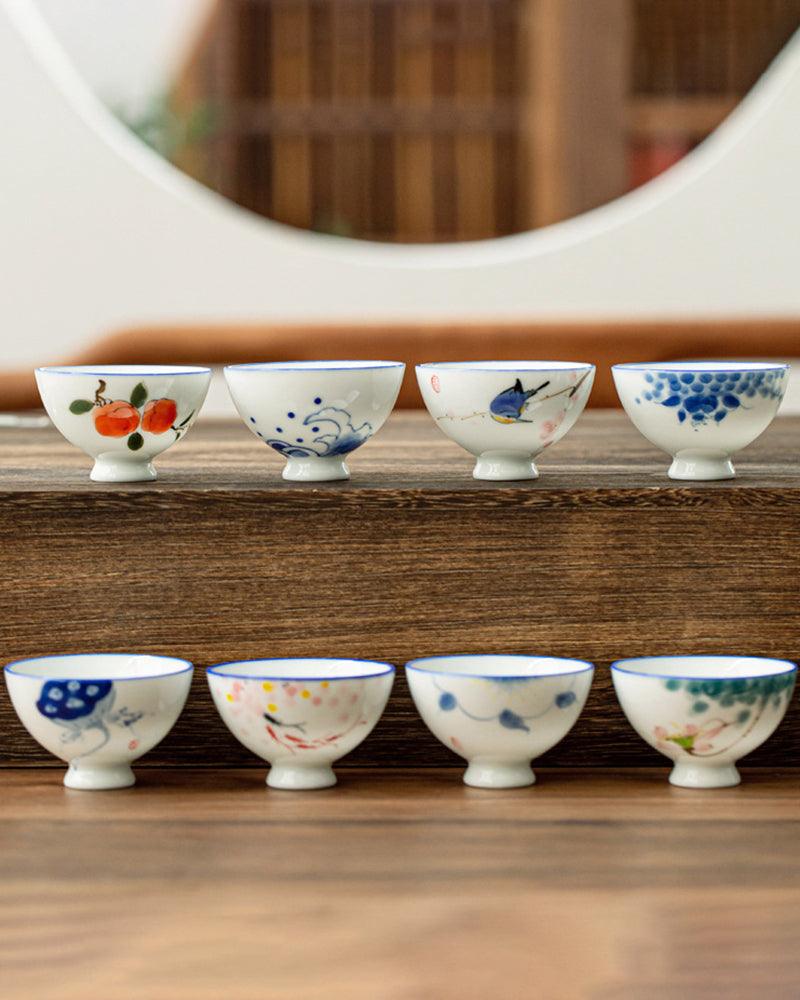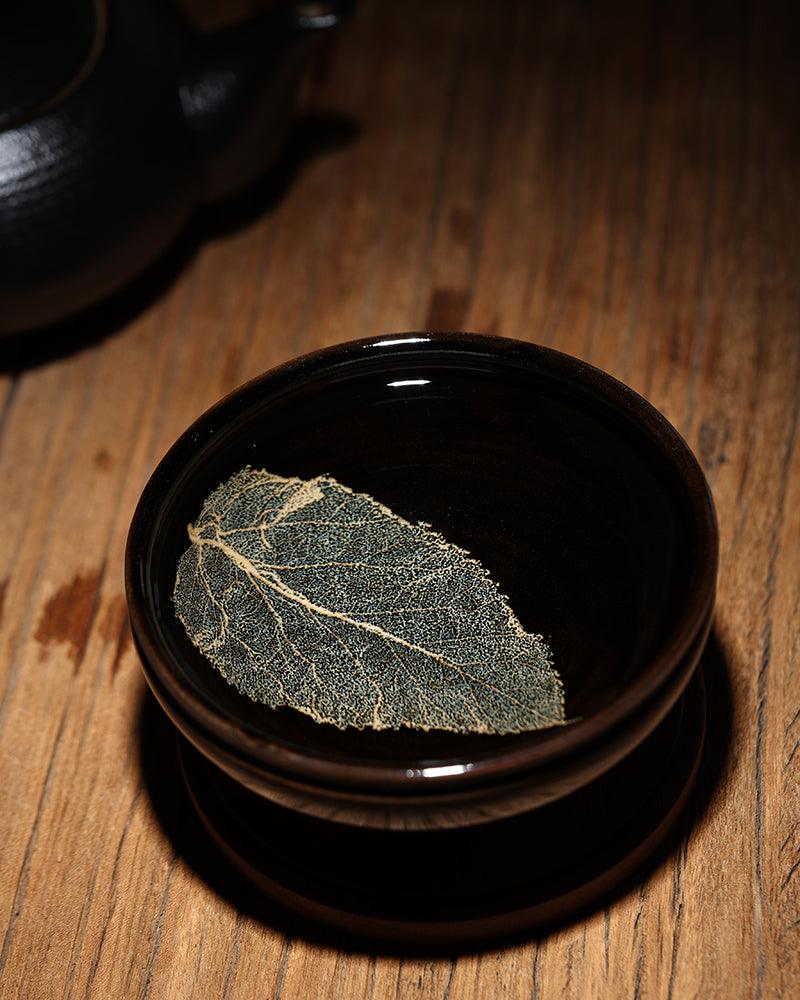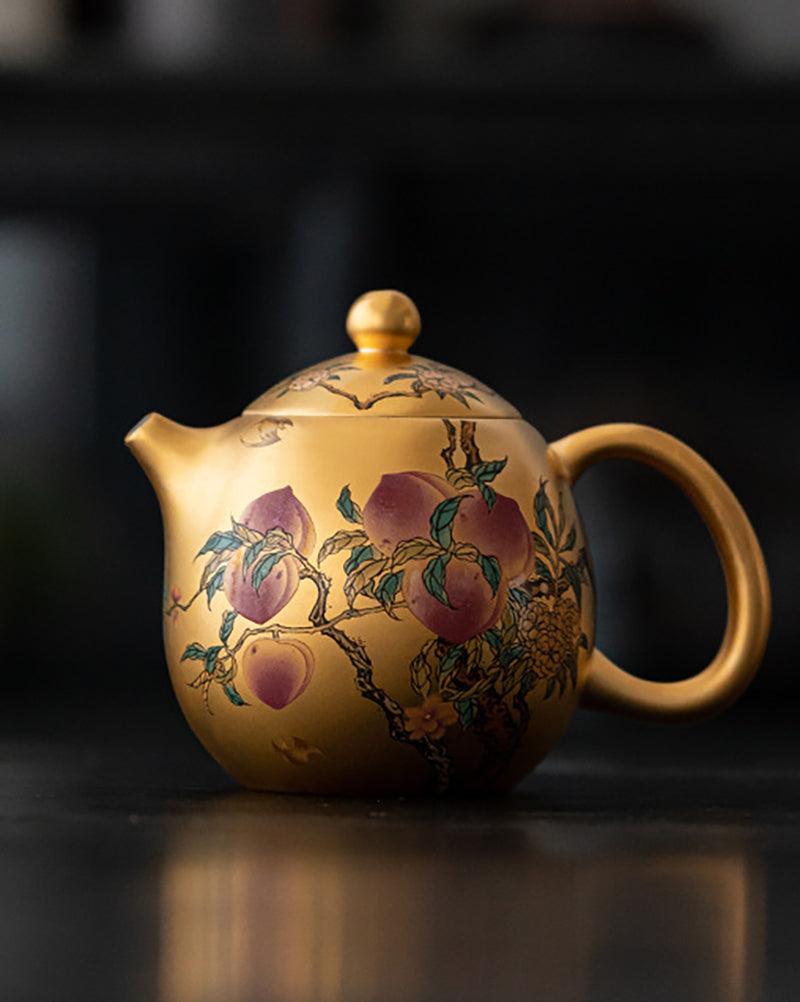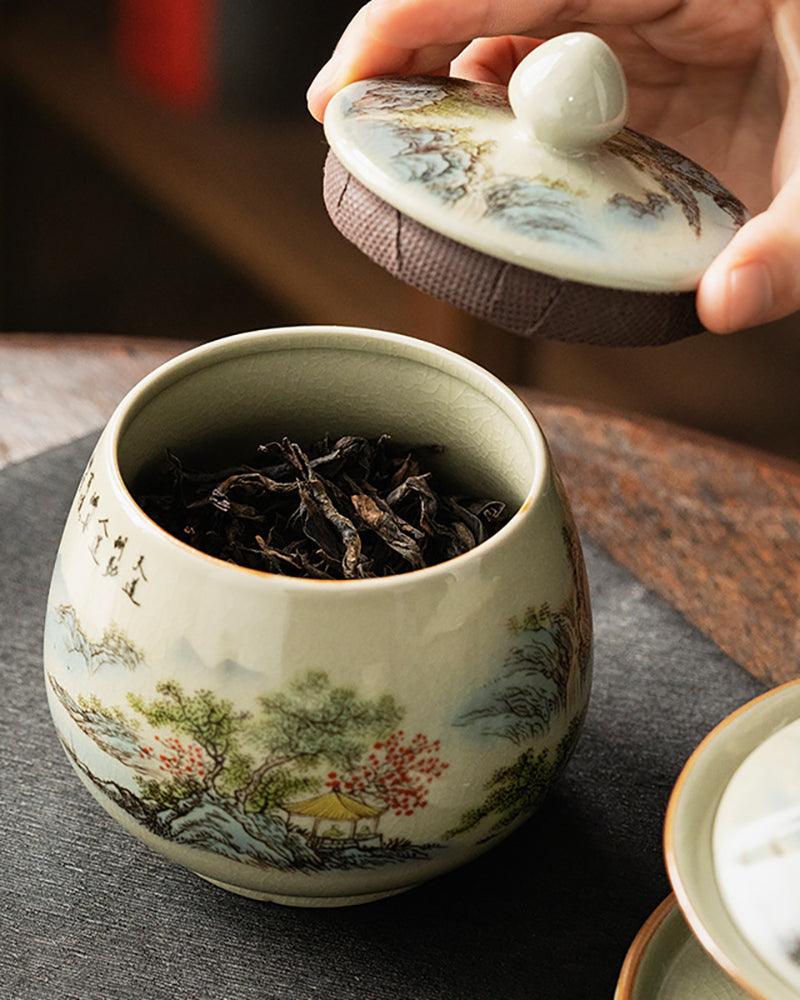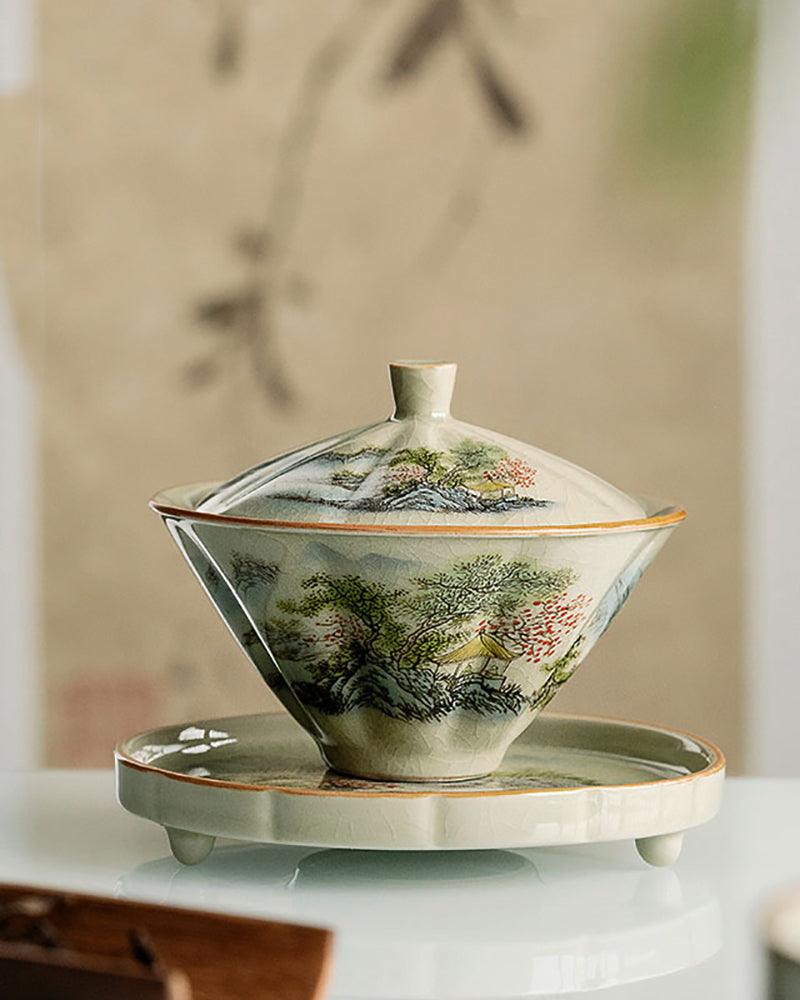







When oriental gaiwan meet western latte




Due to the unique wide-openning design of the bowl, the gaiwan is more suitable for latte art than traditional coffee cups, as it provides a larger surface area for drawing your latte art patterns.
Additionally, unlike materials such as plastic, glass, and pottery, the porcelain used to make the gaiwan is a neutral, non-porous material that does not absorb the flavor of your drink, making your coffee taste more fragrant and delicious.
FAQs
What's Gaiwan Tea Set?
A gaiwan is a small lidded bowl, usually made of porcelain, ceramic or glass. It holds 100-150 ml and is used for brewing and serving tea.
The lid is round and flat with a handle for easy lifting. It controls temperature, infusion time and strains loose leaves. The lid does not affect the tea's flavor. Unlike metal or plastic teapots, porcelain does not alter the taste. This ensures full, authentic flavor from the tea leaves.
Gaiwans are important in traditional Chinese tea culture. They are essential tools for preparing tea. In tea ceremonies, leaves go in the gaiwan. Hot water is added. The lid controls steeping time. Guests often drink directly from the gaiwan or pass it around.
Gaiwans are prized for their simplicity and versatility. They allow precise control over brewing and can make any tea: green, black, oolong or pu-erh. Today, tea enthusiasts use gaiwans for loose-leaf tea worldwide.
Gaiwans also have cultural significance and beauty. Handcrafted gaiwans may have intricate decorations, making a unique addition to any tea set.
Some key benefits of gaiwans:
- They do not affect flavor. Porcelain extracts only the tea's essence.
- They enable control and customization. The lid controls steeping time for optimal flavor from each leaf. More leaf or longer steep for subsequent cups.
- They facilitate a creative, hands-on process. Adjusting water temperature and leaf amount produces nuanced flavor with each cup.
- They have cultural meaning. Gaiwans represent a traditional tea ceremony and passing of tea as a shared, valued custom.
- They offer versatility. Gaiwans work for all teas: green, black, oolong, pu-erh as well as snacks, rice or other small foods.
- They provide aesthetic value. Decorative, handcrafted gaiwans become treasured objects of beauty and memories.
- They inspire mindfulness. The focused, hands-on process of preparing tea with a gaiwan cultivates presence and appreciate for simple moments.
In summary, gaiwans embody the philosophy that the journey is as important as the destination. They make the preparation and sharing of tea an art, rather than a habit. When using a gaiwan, each gesture becomes meaningful, and each cup a new creation.
How to use Gaiwan tea set?
- Fill the gaiwan with dry tea leaves: Place a small amount of tea leaves in the gaiwan, making sure not to overfill the bowl. The amount depends on the tea and personal preference.
- Heat the gaiwan and rinse the tea leaves: Fill the gaiwan with hot water (around 85-90°C) and swirl to rinse the leaves. This removes dust/debris and warms the bowl for steeping.
- Steep the tea: Discard the rinse water and add hot water to the gaiwan. Put the lid on and steep the tea for 2-5 minutes as desired. The lid controls steeping time and can be removed to check strength.
- Pour the tea: Hold the gaiwan by the handle and pour the tea into a cup or pitcher, avoiding leaves. Refill the gaiwan with water and re-steep as needed for more cups.
- Enjoy the tea: Savor the aroma and flavor. Adjust steeping time and water temperature for next steeps.
Note: Use water at the correct temperature for the tea. Too hot extracts bitterness, too cool produces a weak tea. A thermometer ensures accuracy.
The keys to good tea from a gaiwan are:
- Using a quality tea and properly heating the gaiwan to avoid bitterness or weakness.
- Rinsing the tea leaves briefly to remove debris before steeping. This helps the leaves unfurl and infuse the liquor.
- Measuring the tea leaves and water volume carefully for each steep. Start with a lower leaf amount, as re-steeping the same leaves reduces flavor. Add a bit more leaf for subsequent steeps if desired.
- Timing each steep to avoid over-extraction. Check the tea, discard excess leaves and adjust time up or down for the next steep.
- Allowing space for oxygenation between steeps. Pouring the tea into a separate container allows it to sit and breathe before the next steep. This helps maintain color and prevent bitterness.
- Adjusting the water temperature and leaf amount to achieve your perfect flavor for each steep. The process of repeatedly steeping one batch of leaves allows for customization and nuance.
- Appreciating the process and results. Savoring fresh, high-quality tea prepared with care and skill enhances the overall experience of gaiwan brewing.
Why does tea taste better when using a porcelain Gaiwan tea set?
Porcelain is a neutral material that does not interfere with the flavor of the tea. Unlike metal or plastic teapots, porcelain does not alter the taste of the tea, ensuring that you get the full, authentic flavor of the tea leaves.
A gaiwan allows for greater control over the steeping process, giving more control over steeping time and water temperature. This helps bring out the optimal flavors and aromas of the tea leaves.
The lid of the gaiwan can be used to strain loose tea leaves, ensuring only the tea liquid ends up in your cup without any bits of leaves or debris. This not only results in a cleaner and more pleasant-tasting tea, but also helps prevent the tea from becoming too strong or bitter.
In traditional Chinese tea culture, gaiwans are often used in a ceremonial setting. This adds an element of ritual and tradition to the tea-drinking experience. This can enhance the overall enjoyment, making it a more meaningful and special experience.
While using a porcelain gaiwan tea set may result in a better-tasting tea, the quality of the tea leaves and the brewing process are still the most important factors in determining the taste of the tea. A high-quality tea, brewed with the proper technique and water temperature, will taste good regardless of the brewing device.
In summary, the gaiwan allows for greater control, precision and nuance in preparing tea. Its material and design help produce a purer flavor and higher-quality cup of tea. However, the gaiwan alone does not make a good tea. Following traditional methods using high-quality tea leaves and the proper technique remain key to unlocking the potential benefits of a gaiwan and achieving an excellent tasting tea. The gaiwan enhances the tea drinking experience but does not replace it. With this in mind, a gaiwan can be appreciated for what it offers - more nuanced preparation and a ceremonial element - rather than viewed as solely responsible for better flavor.
Could I use Gaiwan for drinking coffee, milk or other beverage?
The gaiwan is useful for more than just preparing tea. It can also be used for coffee, milk, hot soup, and other drinks. A gaiwan provides the same benefits for coffee as it does for tea. This includes control over steeping time and water temperature, the ability to strain loose coffee grounds, and using a material that does not affect the flavor.
Some people find additional uses for gaiwans as small bowls or containers. They may hold condiments, nuts, candies, or other small items in their gaiwans.
The versatility of gaiwans makes them handy and multifunctional kitchen and tabletop tools. They are not limited to tea preparation alone. Gaiwans can enhance the experience of brewing and enjoying many hot beverages or snacks. Their usefulness comes from providing more control and less interference over flavors while also offering extra storage space. With some creativity, a single gaiwan can serve many purposes in the home.
Whether steeping leaf or bean, a gaiwan brings out the pure essence of a drink without imparting its own taste. This versatility and ability to let other flavors shine through is why the gaiwan has become a popular vessel in many traditions and continues to spread to new culinary customs. There are many benefits to adopting the gaiwan beyond simply preparing Chinese tea.
How to choose the Gaiwan?
- Material: Porcelain is the traditional material for gaiwans, and is considered the best option for brewing tea. Porcelain is a neutral material that does not interfere with the flavor of the tea, ensuring that you get the full, authentic flavor of the tea leaves.
- Capacity: Gaiwans typically come in small sizes, making them suitable for brewing single servings of tea. Consider the size of the gaiwan and the amount of tea you typically brew when choosing the right size for your needs.
- Ease of use: Look for a gaiwan with a comfortable handle and a secure lid that fits snugly on the rim of the gaiwan. A gaiwan with an easy-to-use lid will make it easier to strain the tea and prevent spills.
- Aesthetics: Gaiwans come in a variety of styles and designs, and choosing one that appeals to your personal style can make the tea-drinking experience more enjoyable.
- Price: Gaiwans can range in price from a few dollars to hundreds of dollars, depending on the material, quality, and design. Consider your budget when choosing a gaiwan, but keep in mind that a higher-priced gaiwan may offer better quality and durability in the long run.
- Handmade: Handmade gaiwans are often made by skilled artisans and may feature unique designs, making them a distinctive addition to your tea collection. It also made from higher-quality materials than mass-produced gaiwans, which can result in a longer lifespan for the gaiwan and a more authentic tea-drinking experience. Ceramics and porcelains products in Glorious Collection are mostly handmade products which carefully made under the following 14 procedures: materials selecting, kneading mud, shaping, drying in shade, triming, biscuiting,paint under the glaze, glazing, load in kiln, firing, taking out from the kiln, decoration firing, finished work.
When selecting a gaiwan, consider your personal preferences, needs, and budget, and look for a gaiwan that offers a comfortable and easy-to-use design, a neutral material that does not interfere with the flavor of the tea, and a capacity that suits your needs.
Is the Gaiwan a great choice for gifts? What's the implied meaning about Gaiwan?
Yes, Gaiwan will be a great gift for parents, friends, business partner or people who enjoys tea. As in traditional Chinese culture, the gaiwan has been viewed as a symbol of wealth, healthy, friendship, good luck and prosperity for a number of reasons:
- Porcelain material: The gaiwan is often made from porcelain, a material that was once considered valuable and rare in China. Owning a porcelain gaiwan was seen as a symbol of wealth and prosperity.
- Auspicious symbols: The gaiwan is often decorated with auspicious symbols, such as dragons, peonies, and other symbols of longevity and good fortune. Drinking tea from a gaiwan decorated with such symbols was seen as a way of inviting good luck and prosperity into one's life.
- Gift giving: In some cultures, giving a gaiwan as a gift was believed to bring good luck in business. The recipient would be able to enjoy a good cup of tea and relax, thereby helping them to make better business decisions.
- Relaxation: Drinking tea from a gaiwan was seen as a way to relax and unwind, which was believed to help with decision-making and overall success in life.
It's important to note that these beliefs and meanings are not universal and may vary between different cultural and historical contexts. However, the gaiwan has long been associated with good luck and prosperity in many traditional Chinese cultures. Whether viewed as a symbol of wealth, a source of relaxation, or a gift that brings good luck, the gaiwan has a rich cultural history that is closely tied to the tradition of tea-drinking in China.
-

Different aesthetic experience
We work with over 100 artisans across 20 different ethnic minorities. Glorious Collection provides customers with a visual feast of oriental minority aesthetic experience. Our handiwork range from traditional tea set, embroidery bags, Tibetan Silver, Mala beads, Thangka, The Miao Silver,to different jewelry with traditional and cultural designs.
-

Mission
In today’s industrialized world, many artisans now struggle with challenging times.By supporting our artisans, sustainable sourcing helps to preserve local cultural heritage. Through prioritizing products made by local indigenous craftspeople, businesses can help with artistic practices and craftsmanship.
-

Social responsibilities
We apply a portion of our profits to support our artisans, an endeavor we believe will honor both handcrafting heritage and the economy.Sustainable sourcing takes working with indigenous groups and respectfully understanding about their traditional culture to ensure the ethical sourcing of products. This support helps artisans to continue their crafting work and carry forward their cultural traditions to future generations.
























